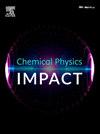Theoretical analysis of non-fullerene acceptor based bulk heterojunction organic solar cell with copper based Hole Transport Layers
IF 4.3
Q2 CHEMISTRY, PHYSICAL
引用次数: 0
Abstract
The enhanced efficiency and stability of non-fullerene acceptor bulk heterojunction organic solar cells (NFA-BHJ-OSCs) in comparison to traditional fullerene acceptor solar cells, have drawn significant attention. The primary aim of this study is to examine the impact of various copper based Hole Transport Layers (HTLs) to increase the electronic conductivity of the cell. It is anticipated that using proper HTL and optimizing its specific parameters will result in the highest efficiency within these structural configurations. The performance of bulk heterojunction organic solar cell based on a Non-Fullerene Acceptor has been investigated using SCAPS-1D. The study dealt with the utilization of TiO2 as the ETL and CuSbS, CuO, CFTS, CBTS, CuI, Cu2O as the HTL and found, PBDB-T:ITIC absorber layer surpasses other absorber layers due to its superior optical and electrical properties, when coupled with Cu2O as HTL and TiO2 as ETL. The changes into the absorber layer thickness, defect density, and doping level are carried out numerically to determine their effect on device performance and efficiency. We determined the Short Circuit Current Density, Open Circuit Voltage, Fill Factor, and Power Conversion Efficiency (PCE) to be 19.38 mAcm−2, 1.0893 V, 78.14%, and 16.50%, respectively, based on our optimization efforts.
铜基空穴传输层非富勒烯受体体异质结有机太阳能电池的理论分析
与传统的富勒烯受体太阳能电池相比,非富勒烯受体体异质结有机太阳能电池(NFA-BHJ-OSCs)的效率和稳定性得到了广泛的关注。本研究的主要目的是研究各种铜基空穴传输层(HTLs)对提高电池电子导电性的影响。预计使用适当的html并优化其特定参数将在这些结构配置中产生最高的效率。利用SCAPS-1D研究了基于非富勒烯受体的体异质结有机太阳能电池的性能。本研究以TiO2为ETL,以CuSbS2、CuO、CFTS、CBTS、CuI、Cu2O为HTL,发现当以Cu2O为HTL、TiO2为ETL耦合时,PBDB-T:ITIC吸收层由于其优越的光学和电学性能而优于其他吸收层。对吸收层厚度、缺陷密度和掺杂水平的变化进行了数值计算,以确定它们对器件性能和效率的影响。基于优化结果,我们确定了短路电流密度、开路电压、填充系数和功率转换效率(PCE)分别为19.38 mAcm−2、1.0893 V、78.14%和16.50%。
本文章由计算机程序翻译,如有差异,请以英文原文为准。
求助全文
约1分钟内获得全文
求助全文
来源期刊

Chemical Physics Impact
Materials Science-Materials Science (miscellaneous)
CiteScore
2.60
自引率
0.00%
发文量
65
审稿时长
46 days
 求助内容:
求助内容: 应助结果提醒方式:
应助结果提醒方式:


